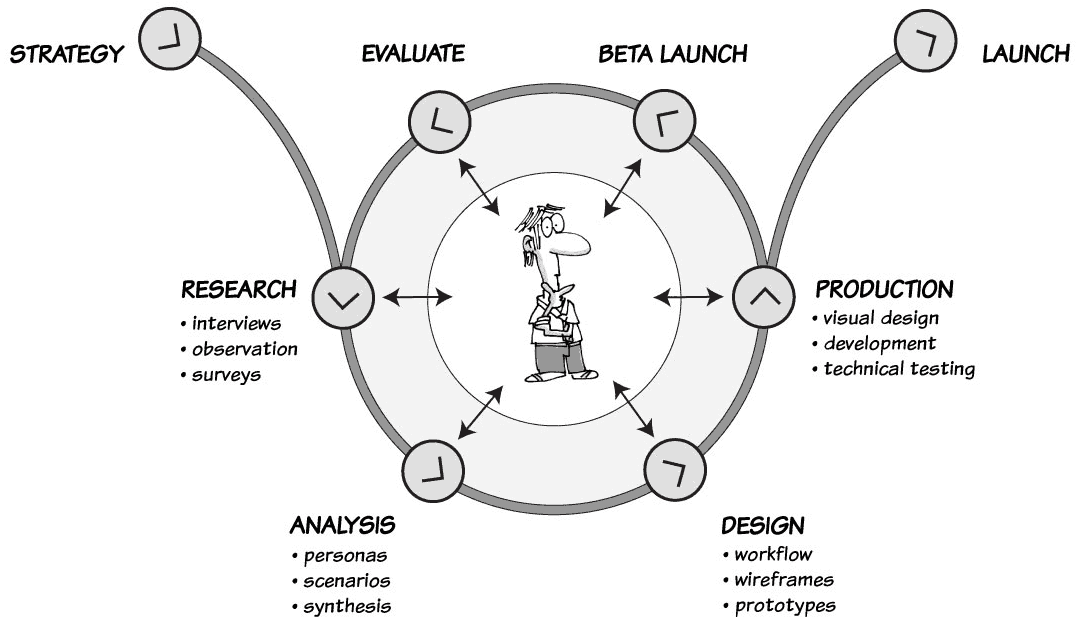Landing a job as a company’s only user experience pro is an amazing opportunity. It means having the ability to shape and guide the design of an entire organisation. As a UX team of one, you’re part of a small group of pros at the coal face of an entire organisation’s design strategy.
Leading an organisation from this role is also a major challenge. It’s hard work implementing a UX focus in a company where none exists. There will be battles against corporate biases, conflicting business needs, and results-driven culture.
In such a difficult position, how can a UXer go about creating a culture of great user experience?
It’s imperative to establish a baseline process, socialise the benefits of great UX, and prepare for the long road ahead.
Above all else, establish a process
When starting a culture of user experience focus, the first step is to establish a clear UX process.
“UX process is a cornerstone of UX design, it’s a make-it-or-break-it aspect of UX design,” writes veteran UX professional Nick Babich in his blog for Adobe.
“Without a solid UX design process, a designer could be completely moving in the dark. A clear and concise UX process, on the other hand, makes it possible to craft amazing experiences for users.”
Every UX professional should have a favoured baseline process. In fact, you’d expect this to be the first question in any UX interview. Part of any quality answer to this question should be to acknowledge the importance of context. No two companies or products are the same. Processes should differ depending on organisational needs, technology stacks, and delivery speed.

No process is bound to be the perfect fit. An initial process’s existence is more important than its perfection. Install a process to address the largest problems and work to resolve the kinks later.
Whatever process you choose, tailor it to your organisation’s needs. This will help you with the second facet of gaining UX buy-in: socialising UX benefits among stakeholders.
Socialise the benefits of UX among stakeholders
In his Forbes piece Good UX is Good Business, Andrew Kucheriavy, founder and CEO Intechnic, lays out the argument for the business benefits of an improved focus on user experience.
“Good user experience is clearly good for business,” he writes. “ Studies show that companies that invest in UX see a lower cost of customer acquisition, lower support cost, increased customer retention and increased market share.”
While the benefits are clear, you must be able to explain why the UX process is beneficial to your stakeholders.
UX success hinges on the cooperation and participation of the business as a whole. While you are the engine propelling the car, the whole machine must move forward together. It’s often difficult for internal stakeholders to see the progress and impact of UX focus. By clearly explaining the benefits, you’ll bring your company one step closer to fully embracing a culture of great user experience.
I’ve written previously on how big of a part UX professionals play in facilitating internal communication. We sit at the epicentre of our business. We speak with our business partners to understand project requirements. We work with our technical teams to understand what’s viable, and to support development efforts. We talk with customers to understand their wants, needs, and expectations. An established process allows UX pros to speak about the project pipeline and its direct impact to any stakeholder.
If we are successful as UX professionals, the benefits we add to our organisations should be clear. Our business partners should have a better understanding of our customers’ needs through UX testing. Our technical teams will receive projects that are both practical and well-defined through iteration and revision with our business partners. And, most importantly, our customers receive a product that exceeds their expectations.
Be aggressive in explaining your expected benefits. Take advantage of your team’s rituals and culture to discuss your roll and how your process will benefit specific projects and initiatives. This gives UX pros excellent opportunities to speak on how and why our process benefits the company as a whole, and gain allies in promoting usability throughout the company.
Cindy McCracken, a UX professional with more than 10 years of experience working for the likes of Fidelity Investments, agrees.
“The more you work with co-workers such as support, sales and development and show them the value of UX, the more support you will have within the organisation,” she writes in her article Proven Strategies to Win Over Stakeholders for Your UX Project. “These in-the-trenches supporters will see the value of your work and the successes with customers first hand, and that will go a long way toward impacting workplace culture and filtering up to senior level support of UX.”
There are a few ways UX professionals can quickly integrate themselves into the rhythms of the business.
Attend development standups. Listen for blockers and speak about how your UX process will ease these issues in the future. Pay attention for upcoming work, and ask for inclusion where practical.
“In planning meetings, be alert for extensive development work planned to go work with interfaces that clearly need to be redesigned,” writes McCracken. “Rather than just let them proceed, bring potential design problems and ideas for improvements to the team.”
Set meetings with your business partners. Work to understand their underlying problems. Explain UX’s role in fixing those issues. Find the low hanging fruit to get some quick wins on the board.
Take part in retrospectives. Retrospectives are a great platform to show the type of value you can provide for your new team.
Listen for issues on previous releases. Present your UX process after discussing these issues. Prepare to speak on your process, and how that will affect any issues raised. After your first couple of releases, plan on asking for feedback to adjust your basic process.
Get in front of your customers. Some would argue that it’s not UX unless you’re getting in touch with your users. This is where great UX starts and ends. Working with your clients shows your engaged in their needs. It allows you to talk about projects that are in development. And it allows you to understand wants, needs, and pain points. We take all this back to our business partners to help create a better product.
According to McCracken, a great way to do this early in the game is to test early iterations of projects with your clients.
“[Use] an online first-click test to see if participants go where you expect when asked to perform tasks,” She writes. “You can even ask what people notice first on a page. Better yet, run one study with an image of your current design, and one with an image of the new design to see how user performance compares. If you have a clear winner, it should be easy to get buy-in to improve conversions, which would be a great return on investment.
Prepare for the long road ahead
The road to establishing UX as a team of one can be difficult and lonely at times. Larger teams, for starters, can divide and conquer work.
A team of one, however, does not have that luxury.

As solo teams, it’s important to take some steps to avoid over-extension. With no one to pick up the slack, whiffing on an objective or project can have major consequences. What’s more, the stress of working alone can be intimidating.
So how can you make life as a solo UXer easier on yourself?
Work with your higher-ups to set reasonable goals and benchmarks. Talk about when you’d like to have processes installed and how you’d like to go about its implementation. Make sure that everyone is clear on mutual expectations and goals. Review your progress and blockers regularly.
Engage with the larger UX community. One mind rarely surprises itself. In larger teams, UXers have comrades to give feedback. In solo teams, isolation can inhibit creative solutions and stunt professional development. Go to UX meetups. Follow industry leaders on Twitter. Start a blog. Ask and answer questions on Stack Overflow. Join an online UX group like the wonderful UXMastery Community. Whatever you do, get involved with the UX world as a whole in some way. Your conscious and career will thank you.
Conclusion
Working as the solitary UX professional in your organisation is not an easy job, but it can be tremendously rewarding.
In Leah Buley’s The User Experience Team of One: A Research and Survival Guide, she makes the best case I’ve yet seen for the allure of working as a UX team of one. The team of one’s work is as close as one can get to the fundamental values of the UX community as a whole.
“UX is a force for good,” she writes. “[As a team of one,] you help spread the growth of a new and exciting field, one person, team, and company at a time.”
What do you think are the greatest challenges for the solo UXer? Share your thoughts in the comments, or join the conversation in our friendly forums.






I’ve been the solo UX-er for two companies now (not by choice), and it’s worth underscoring the challenges one faces as the lone voice for UXD. At both companies, I have been a UX Designer in title only. I do not have the support from leadership to conduct user research, so the reality is I am just a UI Designer. Without the user research, opinions on the team more or less have equal weight. None of us truly knows what users need, which leads to conflict and frustration, not to mention a poor user experience.
This is just my two cents but being a solo UX-er is more challenging than it’s worth. I’ve seen some of the rewards you listed, but as you point out, it’s a long road (years really) to begin seeing the fruits of your labor. You’ll need a lot of patience and persistence to achieve that. In that same amount of time you could be at a company with an established design process and culture, developing your skills and learning new UX methods. To each their own, but for me it’s just not worth it.
I can definitely understand this sentiment. Working on your own you’re swimming upstream all the way. It can be a great way to build skills and learn lessons, but may not be a great fit for everyone – especially those new to the UX world.
This article and comments really speaks to my experience as a solo UX designer at a tech start-up. My company has no product team, no user-centered design, user testing or real involvement with users or user research.
Our design process consists almost entirely of engineers sitting in a room having never spoken to nor met a single user of our product and arguing about UX design. I do not consider this to be design but they see no issue with it.
Since they’re the ones that have to build the product, their opinions carry the most weight and like others have mentioned, I’m basically a UI designer but not by choice. I would not recommend this experience to a new designer as you will almost always be outnumbered and outvoted by whatever the pre-dominant force is at the company (in my case, engineering).
I can only agree with Kevin. I am currently the UX team of one in an agency. I wouldn’t recommend it to someone without minimum 5 years of experience (basically someone senior). Otherwise you will be eaten by the crowd. I don’t want to say it was a mistake I took the job, but it’s not worth at all, unless you want to prove something to yourself/ somebody. The problem with being the only UXer is the money. Agency doesn’t want to pay £80k for senior designer who will own the process. In the same time, the senior designer is not interested in let’s say wireframing. That’s why they hire someone with some experiene, for half the money. This person is happy to do everything, but lacks in experience. That’s the UX team of one circle I know from my and my friends experience. In summary: try, if you are looking for a challenge. Do not try, if you want to learn something.
Guys… The struggle is real! I’ve been recruited to be a Lead UX Designer at a company (startup environment) and one would think, people advocating for UX, understands UX… Uhm, clearly not! As many of you mentioned, I’m a glorified UI Designer, not by choice but by how we approached things.
I’ve read this approach to establish a process – First thing I tried to do but there’s absolutely NO interest or buy-in to establish a process. Despite our KanBan inspired approach with no roadmap or proper prioritizing, I often hear the words: “If this process will help YOU understand the problem better / to achieve optimal outcomes, then go for it!” I’ve refined my Strategy documents to literally 4 blocks to try and get engagement, due to the fact that everybody hates documentation but still nothing. No one seems to agree on any outcome nor how it should be measured. Workshops are out of the equation as the whole team is hardly available. I’ve been pushing to be included in meetings whenever we have a roadmap / possible direction meetings, but I’m being excluded from those, according to me, deliberately.
So our team is currently doing a KanBan approach as mentioned, so we keep on feeding the conveyer belt, operating from a point of subjectiveness when it comes to prioritizing and ignoring some of the IN-HOUSE clients’ frustrations.
In all honesty, I’ve sort of given up to establish a UX process or to change the inner workings of the company to be more User Centered. Especially when I’m constantly being overruled by Head of Dev or PM’s purely because the process seems like a drag.
I agree that it can be very rewarding and that it can be done BUT without any real investment or collaboration, I can’t think of a way that UX will ever work apart from UX-ers being utilized as UI Designers…
One thing that is critical to note going into a job like this, is make sure upper management already has support/buy-in during the interview process.
I did this with my company and I have full support. One of the first things we’re doing is defining that process as a team to make it work for our company.
My last company is exactly the same situation you’re going through. I learned from that experience and was able to arm myself with questions to ensure I was finding myself in the right place. What does User Experience mean to you? What is the value of User Research to your company? (I also had a requirement that they MUST ASK ME about my process.) I also asked them what the differences between UI and UX design was. Basically grilled them on their understanding. ♥️
I completely agree with the comments here. It sounds like the fundamental problem in these companies is that they lack sound product development practices (ya know, business strategy, who’s our target customer, how are we gonna make money? type stuff), without which, it’s pretty impossible to have user-centered design.
I got out of a similar situation by finding an advocate among leadership. I think that’s really key.
Good user experience is clearly good for business,” he writes. “ Studies show that companies that invest in UX see a lower cost of customer acquisition, lower support cost, increased customer retention and increased market share.”
Can you link to these studies, it would be so helpful. I’m in this position right now in my career.
J
I think this article is spot on. I’m a UX of one, but have years of experience in this field that include multiple years of consulting with high level clients. The truth is, that this is not for everyone. You have to be established in your methodology and have the experience to understand where to integrate when no one knows what you do. This is not suited for entry level designers and even most mid level. Our field is a bit ambiguous to most not in it. Even amongst each other you find a struggle in explaining what we do. However, this falls on us to educate our clients and organization as to the benefits of an experience focused approach. Understanding that UX is just a small piece of the experience process is key in understanding how to interface with your leadership. I have interacted consistently with CEOs and all levels of executives and have stood in front explaining why their vision is flawed and why we should initiate better processes and workflows that focus on the experience while aligning to business objectives. It is not easy, but for those that enjoy creating strategy and evangelizing the practice, this is well worth it. Be confident in your expertise and as far as salary goes, you hold the keys by commanding your worth based on your knowledge. Believe me when I say that as long as you are knowledgeable and keep up to date with your practice, you would be amazed how much can get done. Also, be willing to understand all aspects of your company or client. Understanding their part to play will give you the foundation to start conversations on how you can improve them.
Thank you so much for your insightful comment, M. I feel like I want to print it and put it on my wall to keep me going LOL
I’ve been the solo UXer in my company for a while now. When I started I had to prove the value of my work – answering what felt like 100s of questions about my process, presenting and writing documents about what I was doing and why (especially why we actually needed to talk to users).
But, it only one project, with real comments from real people to sway the right people. Some of those have left (and I’ve had to train new people in the joy of UX) but those who are still there value me, my work and are my champion. Yes it can be tough, but if you do a good job, get the right people on your side and continue to prove the value of UX the work can be varied and fun. It’s all about what you make of the job.
(PS… and when I wonder if I am missing new skills by not being elsewhere I train – go to a conference, read, I even once went to a beginners UX course to check my processes. I’m alone but not on my own!)
I may have rose colored glasses on, as my comment has a different tone than many others. :P
I’m just getting started as the one-woman design team at a startup. Throughout my recent job search I got a lot of feedback about my work being “too UXy” to land a Product Design job, which I applied for almost exclusively. So, the thought of being more UI focused is OK for me to get balanced. At the same time, I’m excited about the idea of bringing the user’s voice into the process here for the first time. There are so many processes to be put in place that I took for granted at my last big corporate job. So I am hoping that I can prove out these processes to be valuable.
There’s a lot of opportunity for me to learn and grow here. Whether or not that will be a pleasant experience overall is another topic. We shall see. :)